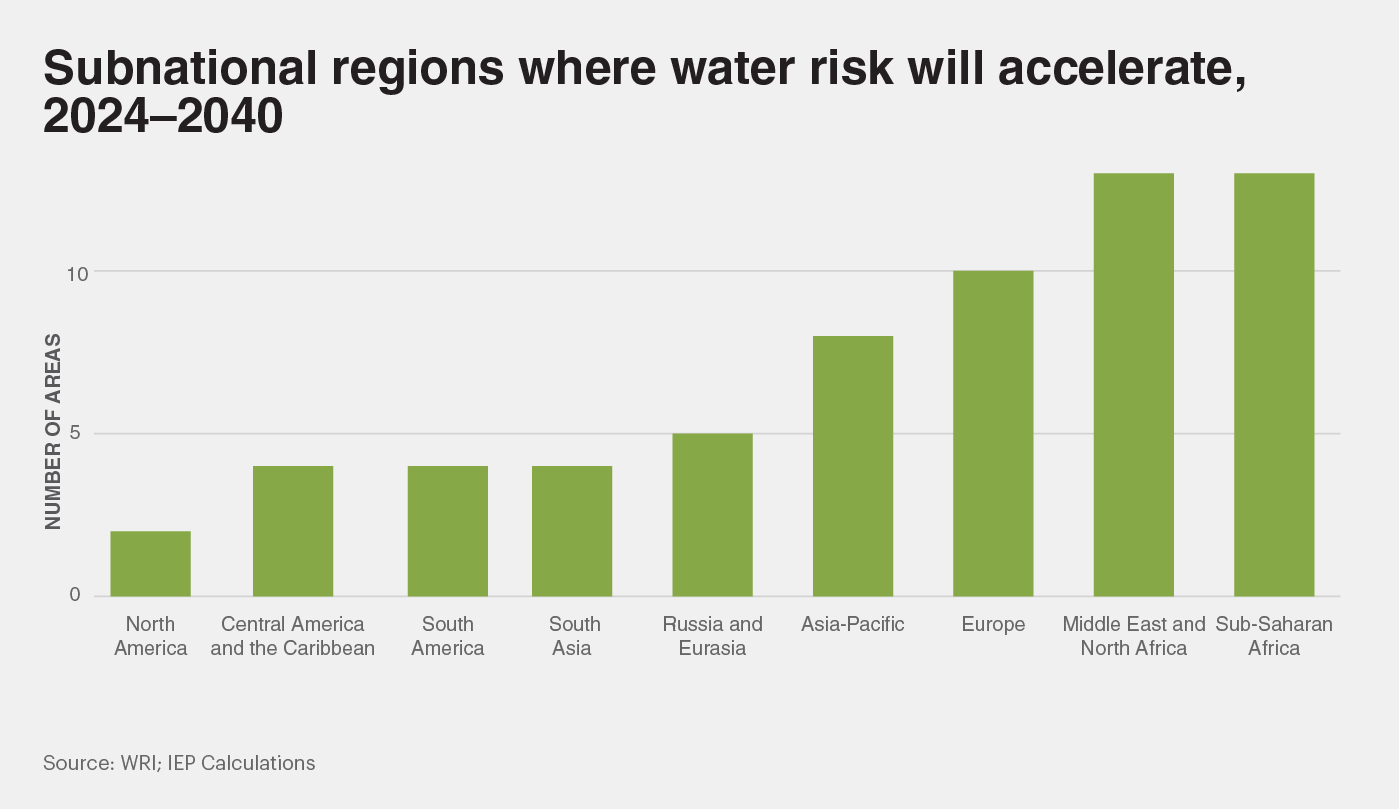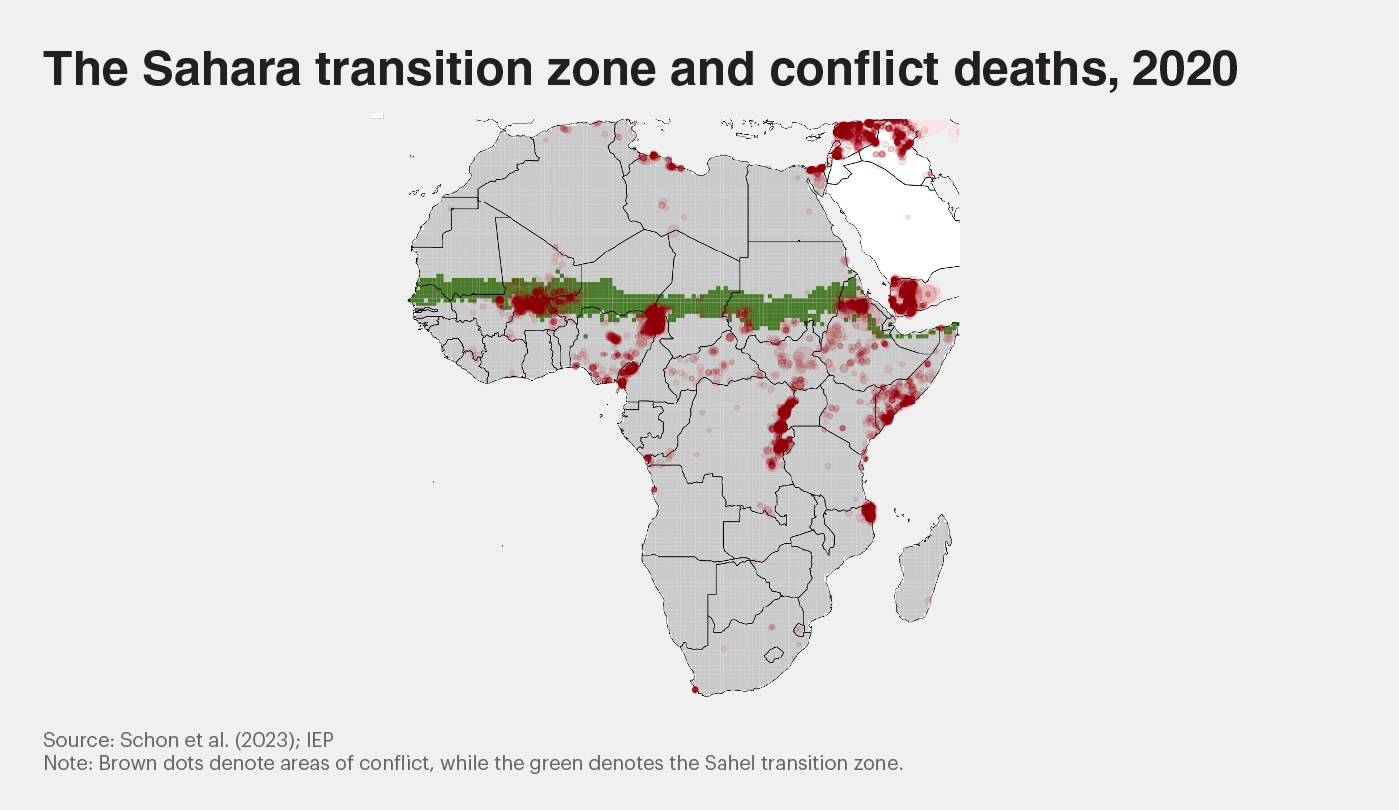In the latest Ecological Threat Report, IEP research explores the correlation between conflict dynamics and historical ethnic borders, an issue that has been exacerbated by rising ecological threats, particularly water scarcity. Heightened water scarcity has led to greater competition for resources, increasing potential intergroup conflict. Strong governance and effective infrastructure development is greatly needed for the mitigation of water-related risks, allowing for the effective management of the available water supply. Effective water management is a key factor towards a reduced risk in conflict, promoting a sustainable development within regions prone to water scarcity and ethnic tensions.
Water scarcity, intensified by climate change, has been a major factor towards conflict between regions. Arid and semi-arid areas are extremely prone to these drastic environmental changes, often leading to violent disputes regarding resources. As the effects of climate change worsen, it is imperative that we strengthen our water management strategies, enabling us to reduce conflict and maintain peace within society.
There is a large global dependency on water for agricultural management. Estimates by the World Resources Institute state that currently, amongst 25 countries, over 80% of their renewable water supply is used for livestock, irrigation, domestic and industry needs. An example of this is Europe, where water supplies depends upon rivers, reservoirs and groundwater extraction. However, high demands from tourism, public water supply and agriculture has limited the quality and availability of water, particularly amongst Southern and South-western countries. This effect is shown in the chart below, with Europe being the third highest region to face increased water-related challenges.

Another major factor contributing factor towards water depletion is the “virtual” trade of water. This occurs with products amongst the global trade market which require a significant amount of water usage for production and transportation. Although this “virtual water export” benefits countries who are indirectly importing water, this is not the case for low-income countries. Due to the water intensive nature of their exports, this leads to increased water stress, the country’s water supply and quality declining. There needs to be a focus on improving water efficiency during product manufacturing and transportation, through the establishment of strong government management systems.
Generally, an individual’s access to water highly depends on a sufficient level of socio-economic development and strong institutions. Inadequate management causes inequitable distributions and excessive extraction. When comparing countries Iceland and United Arab Emirates (UAE), both possess low scores of one on the water risk scale, possessing minimal challenges with their water resources. Although, whilst Iceland has 459,000 m³ of water per person, UAE only has 16 m³. This indicates the UAE’s secure system of government and institutions, allowing efficient management of their limited water resources. This includes desalination plants that supply 42% of the country’s drinking water.
This positive correlation between strong governance and efficient water use is further shown in Papua New Guinea. Despite having over 80000 m³ of water available per capita, the country has a high water risk score of 4.97, indicating issues with their water supply. This refers to the poor maintenance of the country’s water infrastructure. As a result, most of the population, especially in rural areas, are unable to access sanitation facilities and clean water. Through the country’s socio-economic difficulties and ecological threats such as flooding, this further hinders the weak institutions. A strong governance and infrastructure is vital towards the effective management of a country’s water supply.
Without an effective government or institutions, there is a high risk of conflict, demonstrated through the heightened conflict between the ethnic groups in the Sahel region. Within arid and semi-arid regions, cooperation has been difficult between sedentary farming communities (live in permanent settlements) and nomadic pastoralist herders (move from place to place). This had led to an increase of violent disputes over common resources; farmers require water for crop cultivation whilst herders require water for livestock. Due to the intensified periods of drought and reduced rainfall, there has been heightened water stress for both groups. This results in severe consequences, due to 72% of the demographic’s livelihoods relying on agriculture according to the United Nations’ Food and Agriculture Organisation. In particular, the Sahel region is a transition zone, its increased susceptibility to climate change causing huge climate fluctuations. Consequently, the reduction of farming land and grazing areas, as seen in Figure 2.4, has exemplified conflict levels over resources.
The conflict within the Sahel region highlights the potential conflict other countries could also face because of water scarcity. Within the region’s context, community engagement is crucial towards decision-making and infrastructure development processes. By receiving local input and perspectives, a sense of trust towards local institutions has increased, leading to less intercommunal violence. This further reinforces the importance of managing water efficiently through the development of a strong governance, minimising conflict and maintaining peace between societies.

The correlation between climate change, water scarcity and conflict have major implications towards global peace and security. As climate change becomes even more severe, water stress will only rise, worsening pre-existing tensions and even potentially creating new conflicts. To ease these tensions, it is evident that developing a strong government and institutions will allow water usage to be managed much more efficiently. This will minimise levels of conflict and hence sustain higher levels of peace and security within society.